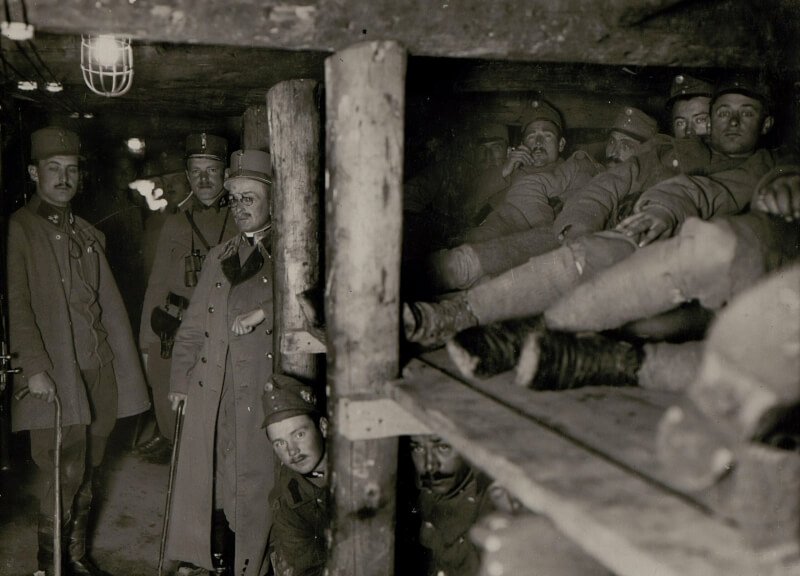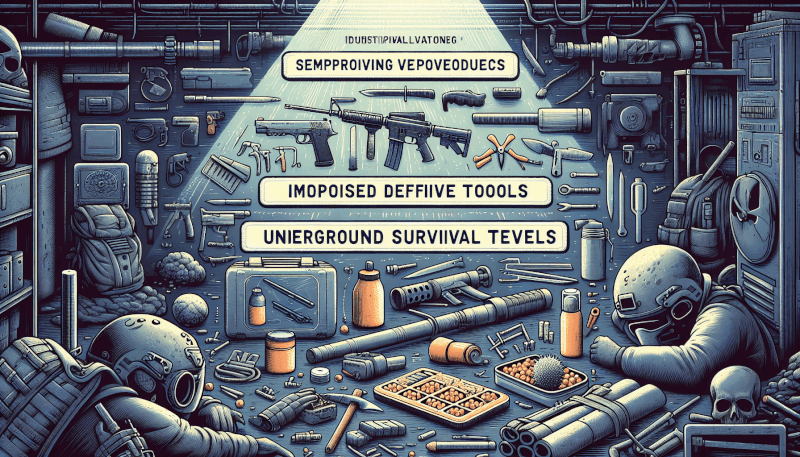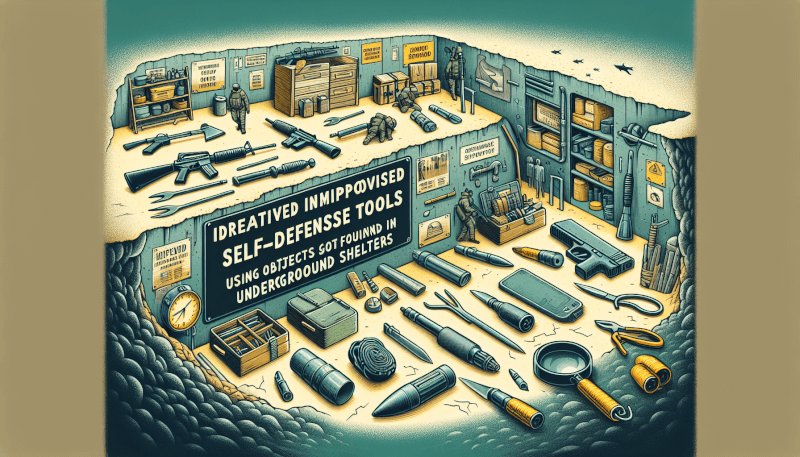In today’s uncertain world, being prepared is of utmost importance. The “Prepper’s Underground Guide to Improvised Weapons” is your ultimate resource for learning how to defend yourself using everyday objects. Delve into a world where anything can become a weapon, from a pen to a flashlight or even a rolled-up newspaper. This comprehensive guide will equip you with the knowledge and skills needed to protect yourself and your loved ones in any situation. Get ready to discover the hidden power in the ordinary and become a true master of improvised self-defense.

Introduction
Welcome to the Prepper’s Underground Guide to Improvised Weapons! In this comprehensive article, we will explore the world of improvised weapons, their definition, benefits, legal considerations, and various examples that can be found in everyday items. We will also delve into specific categories of improvised weapons, such as those used for self-defense, survival, and the necessary training and maintenance required. Lastly, we will discuss the use of improvised weapons in different environments and touch upon the legal and ethical considerations surrounding their usage. So, let’s dive in and learn all about the fascinating world of improvised weapons!
Section 1: Understanding Improvised Weapons
1.1 Definition of Improvised Weapons
Improvised weapons are objects that are not designed or intended to be used as weapons but can be modified or manipulated in a way that makes them effective for self-defense or survival purposes. These objects can range from common household items to tools found in various environments.
1.2 Benefits of Improvised Weapons
The use of improvised weapons offers several benefits. Firstly, they can provide a means of defense or survival in unexpected situations where traditional weapons may not be available. Secondly, improvised weapons are often inconspicuous, allowing you to blend into your surroundings and avoid drawing attention. Lastly, by utilizing everyday items as weapons, you can ensure that you are always prepared, as these objects are readily accessible in most situations.
1.3 Legal Considerations
While improvised weapons can be useful in certain situations, it is crucial to understand the legal implications surrounding their use. Laws regarding the possession and use of weapons can vary between jurisdictions, so it is vital to familiarize yourself with local regulations. Understanding the legal framework will help you make informed decisions and avoid any potential legal issues that may arise.

Section 2: Everyday Items as Improvised Weapons
2.1 Common Household Items
In a typical household, you can find several items that can be used as improvised weapons with a little creativity. Let’s explore some of them:
2.1.1 Pens and Pencils
Pens and pencils may seem harmless, but they can be effective weapons when used correctly. The pointed tip can be used to strike sensitive areas of an attacker’s body, such as the eyes or throat, causing temporary distraction or pain.
2.1.2 Keys
Keys are small and easy to carry, making them an ideal improvised weapon. When held between your fingers, they can be used to strike an attacker’s face, eyes, or other vulnerable areas, increasing your chances of escape.
2.1.3 Belts
Belts are versatile tools that can be turned into improvised weapons. When wrapped tightly around your fist, they can provide additional impact and protect your hand during self-defense situations. Additionally, belts can be used for restraint or as a makeshift sling for transporting items.
2.1.4 Umbrellas
Umbrellas, particularly those with a sturdy frame, can be excellent improvised weapons. With a quick flick, they can be transformed into a defensive tool, offering protection against physical attacks or creating distance between you and your assailant.
2.2 Office Supplies
Office supplies often go unnoticed in terms of their potential as improvised weapons. Let’s explore a couple of examples:
2.2.1 Paperclips
Paperclips may seem innocuous, but they can be fashioned into makeshift lockpicks or used to create simple traps and snares. Their small size and discreet nature make them ideal for covert operations or survival scenarios.
2.2.2 Staplers
Staplers are heavy and sturdy, making them useful in self-defense situations. The weight and texture of a stapler’s body can provide a solid grip and deliver a significant impact when used as an improvised striking tool.
2.3 Kitchen Utensils
The kitchen is an abundant source of improvised weapons. Let’s explore two common examples:
2.3.1 Knives
Knives are the most obvious kitchen utensils that can be used as improvised weapons. Whether for self-defense or survival purposes, a knife can be a valuable tool. Proper training in handling and using knives is essential to utilize them effectively and safely.
2.3.2 Spatulas
While spatulas are typically used for cooking, they can also serve as improvised weapons. The flat, wide surface can be used for blocking or striking, while the handle can provide a firm grip and enable more powerful strikes.
Section 3: Improvised Weapons for Self-defense
3.1 Improvised Firearms
In extreme situations where firearms are not available or accessible, improvised firearms may become a necessity. Let’s look at a couple of examples:
3.1.1 Zip Guns
Zip guns are improvised firearms made from common household items and often operate on the principle of a pipe or single-shot shotgun. The creation and use of zip guns may be illegal in many jurisdictions, so it is essential to consult local laws and regulations before considering such options.
3.1.2 Slingshots
Slingshots, while not designed as firearms, can be used as effective improvised weapons. With the right ammunition, such as ball bearings or marbles, slingshots can deliver significant force and impact.
3.2 Melee Weapons
Improvised melee weapons offer an alternative for self-defense when traditional weapons are unavailable. Let’s explore a couple of examples:
3.2.1 Improvised Clubs
Items like heavy flashlights, wrenches, or even rolled-up magazines can be effectively used as improvised clubs. These objects offer weight, reach, and potential impact, giving you an advantage against an assailant.
3.2.2 Impact Weapons
Impact weapons, such as improvised brass knuckles made from coins, can enhance the power of strikes during self-defense situations. These weapons are easily concealed and can provide an element of surprise.
3.2.3 Improvised Blades
In dire situations, any sharp object can be turned into an improvised blade. Utilizing objects like broken glass, shards of metal, or even sharpened wood can give you an edge when it comes to close-quarters combat.

Section 4: Improvised Weapons for Survival
4.1 Hunting Tools
In survival scenarios, improvised weapons can play a crucial role in obtaining food. Let’s explore a couple of examples:
4.1.1 Slingbows
A slingbow is an improvised weapon that combines the principles of a slingshot and a bow. By attaching an arrow-like projectile to the slingshot, you can launch it with greater accuracy and force, improving your chances of successfully hunting small game.
4.1.2 Fishing Spears
An improvised fishing spear can be made from a sturdy stick or pole and sharpened to form a multi-pronged spearhead. This simple yet effective tool allows you to catch fish or other aquatic life without the need for traditional fishing gear.
4.2 Tools for Gathering Resources
In survival situations, it is essential to be resourceful and gather what you need. Improvised weapons can come in handy for such purposes. Let’s explore a couple of examples:
4.2.1 Improvised Snares
Snares can be constructed from various materials and utilized for trapping small game, birds, or other animals. Utilizing ropes, wires, or even shoelaces, you can create effective snares to increase your chances of obtaining food in survival situations.
4.2.2 Slings for Gathering
Slings can be made from different materials, such as fabric or cord, and used to enhance your throwing abilities. With a well-constructed sling, you can gather fruits, nuts, or even stones for hunting or self-defense purposes.
4.3 Tools for Shelter and Defense
In survival scenarios, improvised weapons serve a dual purpose – ensuring your safety and aiding in the construction of necessary structures. Let’s explore a couple of examples:
4.3.1 Improvised Slingshots
Slingshots, in addition to their self-defense applications, can be used to launch small objects for various purposes. From testing the stability of tree branches to launching grappling hooks for shelter construction, improvised slingshots can be invaluable survival tools.
4.3.2 Throwing Sticks
Throwing sticks, also known as rabbit sticks, are versatile tools that can aid in hunting and self-defense. By perfecting your throwing technique, you can increase your accuracy and distance, making it easier to strike small game or deter potential threats.
Section 5: Improvised Weapons Training
5.1 Self-defense Techniques
While improvised weapons can be effective, understanding proper self-defense techniques is crucial to maximize their potential. Let’s explore a couple of techniques:
5.1.1 Basic Strikes
Training in basic strikes, such as punches, palm strikes, knee strikes, or elbow strikes, is essential in utilizing improvised weapons effectively. Combining these strikes with the proper use and integration of improvised weapons can increase your chances of successfully defending yourself.
5.1.2 Escapes and Holds
Learning escape techniques, such as wrist releases or chokehold escapes, can be invaluable when facing potential threats. These techniques, combined with the proper utilization of improvised weapons, improve your ability to defend yourself effectively.
5.2 Improvised Firearms Training
Proper training is essential when utilizing improvised firearms. Let’s explore a couple of considerations:
5.2.1 Safety Measures
Learning and understanding safety measures, such as proper handling, aiming, and loading techniques, is crucial when using improvised firearms. Safety should always be the top priority to prevent accidents and ensure the well-being of yourself and others.
5.2.2 Firing Techniques
Training to understand firing techniques, such as trigger control and stance adjustment, is vital for accuracy and effectiveness. Regular practice with improvised firearms will increase your comfort and proficiency in utilizing them as improvised weapons.
5.3 Melee Weapons Training
Mastering techniques specific to melee weapons is essential in utilizing them effectively. Let’s explore a couple of considerations:
5.3.1 Grip and Stance
Understanding the proper grip and stance when handling melee weapons is critical for maintaining control and minimizing the risk of injury. Learning various grips and stances allows you to adapt to different situations and maximize the impact of strikes.
5.3.2 Targeting Techniques
Learning effective targeting techniques, such as striking vulnerable areas or utilizing specific angles for optimal impact, can significantly increase the effectiveness of melee weapons. Targeting techniques should be practiced regularly to build muscle memory and improve accuracy.
5.4 Practical Exercises
Engaging in practical exercises that simulate real-life scenarios is essential to improve your overall skills in utilizing improvised weapons. These exercises can include simulated self-defense situations, survival scenarios, or target practice to enhance your proficiency and confidence.

Section 6: Improvised Weapons Maintenance
6.1 Cleaning and Lubrication
Regular cleaning and lubrication are crucial to maintaining the functionality and longevity of improvised weapons. Cleaning helps remove debris or dirt buildup, while lubrication ensures smooth movement and prevents rust or corrosion.
6.2 Repair Techniques
In the event of damage or wear, having basic repair techniques at your disposal can extend the life of your improvised weapons. Learning to repair minor issues, such as loose handles or damaged components, will ensure that your improvised weapons remain reliable and functional.
6.3 Storage Considerations
Proper storage of improvised weapons is vital in maintaining their effectiveness and accessibility. Weapons should be stored in a secure and discreet location, away from the reach of unauthorized individuals. Regular checks should be conducted to ensure the weapons are in good condition and readily available when needed.
Section 7: Improvised Weapons in Different Environments
7.1 Urban Settings
Utilizing improvised weapons in urban settings brings distinct advantages and disadvantages. Let’s explore them:
7.1.1 Advantages and Disadvantages
Advantages of using improvised weapons in urban environments include the accessibility of common items and the potential for surprise. Disadvantages may include legal restrictions, higher population density, and limited space for maneuverability.
7.1.2 Best Practices
When using improvised weapons in urban settings, it is important to blend in, avoid unnecessary attention, and prioritize non-violent solutions whenever possible. Familiarizing yourself with local laws and regulations is essential to prevent legal consequences for the use of improvised weapons.
7.2 Wilderness Settings
In wilderness settings, improvised weapons can be crucial for survival. Let’s explore their adaptability and survival aspects:
7.2.1 Adaptation and Survival
Improvised weapons allow you to adapt to the wilderness and utilize your surroundings effectively. Whether it is constructing weapons from natural materials or using improvised tools for hunting and gathering, the adaptability of improvised weapons is essential for survival in the wilderness.
7.2.2 Building Natural Weapons
In the absence of everyday items, constructing weapons from natural materials becomes necessary. From carving a wooden spear to fashioning a stone knife, knowledge of natural weapon building is essential for survival in the wilderness.
7.3 Vehicle-based Prepping
Utilizing improvised weapons in vehicle-based prepping scenarios brings unique considerations. Let’s explore a couple of them:
7.3.1 Carrying and Accessibility
When prepping in a vehicle, it is crucial to store improvised weapons in an easily accessible manner. Carrying lightweight yet effective tools can be advantageous in a vehicle-based scenario, ensuring that you can reach them quickly when needed.
7.3.2 Concealment Methods
Ensuring that your improvised weapons remain concealed in a vehicle-based prepping scenario is important for security and stealth. Utilizing discreet storage compartments or concealed holsters can prevent unwanted attention and keep your improvised weapons within reach but out of sight.

Section 8: Legal and Ethical Considerations
8.1 Legal Restrictions
Understanding the legal restrictions surrounding the possession and use of improvised weapons is essential. Let’s explore a couple of considerations:
8.1.1 Local Laws
Different jurisdictions may have varying laws when it comes to improvised weapons. It is imperative to be familiar with the laws in your specific area to avoid any legal consequences resulting from the possession or use of improvised weapons.
8.1.2 Transport and Concealment
Transporting and concealing improvised weapons may have their own set of legal considerations. Some jurisdictions may require permits or impose restrictions on how improvised weapons should be stored or carried. Adhering to these regulations is important to avoid potential legal issues.
8.2 Ethical Considerations
While improvised weapons can serve as tools for self-defense or survival, ethical considerations should always be at the forefront. Let’s explore a couple of ethical considerations:
8.2.1 Using Force Responsibly
Using force, even in self-defense, should always be approached responsibly. Understanding when and how to utilize improvised weapons ethically is crucial to prevent unnecessary harm or escalation of a situation.
8.2.2 Prioritizing Non-violent Solutions
Although improvised weapons can be effective, non-violent solutions should always be prioritized whenever possible. Learning conflict resolution techniques, de-escalation strategies, and communication skills can help prevent the need for resorting to improvised weapons in the first place.
Conclusion
Congratulations! You have reached the end of the Prepper’s Underground Guide to Improvised Weapons. Throughout this article, we have explored the definition, benefits, and legal considerations of improvised weapons. We have also dived into various categories and examples of everyday items that can be used as improvised weapons for self-defense, survival, and in different environments. Additionally, we discussed the importance of training, maintenance, and understanding legal and ethical considerations when it comes to utilizing improvised weapons effectively. By being knowledgeable and prepared, you can enhance your personal security and survival capabilities. Remember, the responsible use and application of improvised weapons should always be grounded in a commitment to safety, legality, and ethical considerations. Stay safe and stay prepared!


